
The Berlin U-Bahn is a rapid transit system in Berlin, the capital and largest city of Germany, and a major part of the city's public transport system. Together with the S-Bahn, a network of suburban train lines, and a tram network that operates mostly in the eastern parts of the city, it serves as the main means of transport in the capital.
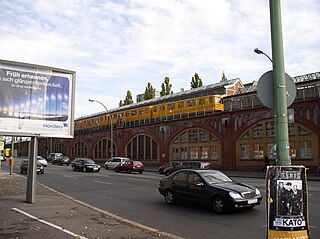
U1 is a line on the Berlin U-Bahn, which is 8.8 kilometres (5.5 mi) long and has 13 stations. Its traditional line designation was BII. It runs east–west and its eastern terminus is Warschauer Straße S-Bahn station where it connects to the Schlesische Bahn. From there it runs through Kreuzberg via Gleisdreieck and Wittenbergplatz on to the Kurfürstendamm.
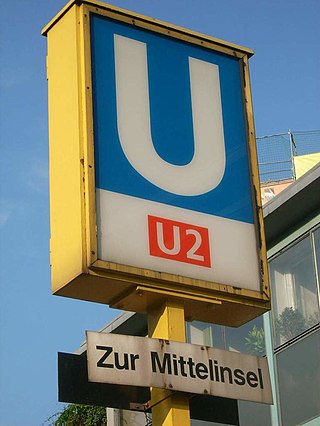
U2 is a line of the Berlin U-Bahn. The U2 line starts at Pankow S-Bahn station, runs through the eastern city centre (Alexanderplatz) to Potsdamer Platz, the western city centre and finally to the Ruhleben terminal station.

The U4 is a line of the Berlin U-Bahn in Germany, the shortest in Berlin's U-Bahn system with a length of 2.86 kilometres (1.78 mi). It serves five stations, with only the two termini being step-free. Opened in 1910, it is the only subway line in Berlin to have never been extended and the only one to have no night service on weekends.
The U7 is a rail line on the Berlin U-Bahn. It runs completely underground for a length of 31.8 kilometres (19.8 mi) through 40 stations and connects Spandau, via Neukölln, to Gropiusstadt and Rudow. The line was originally the south-eastern branch of the Nord-Süd-Bahn (U6) that ran between the branching point at Belle-Alliance-Straße (Mehringdamm) and Grenzallee; however, in the 1960s, this stretch was separated from the rest of the line and extended at each end to form a new line. As of 2007, the U7 is Berlin's longest underground line, both in terms of absolute length and total travel time, and one of the longest (entire) subterranean lines in Europe.

U3 is a line on the Berlin U-Bahn created in its current version on 7 May 2018.

A ghost station is a disused train station through which revenue-service passenger trains pass but at which they do not stop. The term is also sometimes used for any unused underground station or any unused station, whether or not trains pass through them. In Germany, a station that has been built in the course of constructing something else as a so-called "Bauvorleistung" is referred to as a "ghost station", despite the different purpose and origin of the terms. Some English-language publications also refer to "pre-built" stations or parts thereof that have yet to see service as "ghost stations".

Wittenbergplatz is a Berlin U-Bahn station on lines U1, U2, and U3. The station is located at the Wittenbergplatz square in Berlin's City West area, in the northwestern corner of the Schöneberg neighbourhood. It is the only U-Bahn station in the city with five adjacent tracks and three platforms. The station building, erected in 1911–1913 according to plans designed by Alfred Grenander, is listed as an architectural monument.
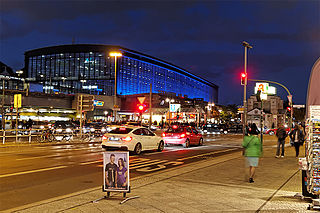
Berlin Zoologischer Garten station is a railway station in Berlin, Germany. It is located on the Berlin Stadtbahn railway line in the Charlottenburg district, adjacent to the Berlin Zoo.

Berlin Hauptbahnhof is the main railway station in Berlin, Germany. It came into full operation two days after a ceremonial opening on 26 May 2006. It is located on the site of the historic Lehrter Bahnhof, and on the Berlin S-Bahn suburban railway. The station is operated by DB Station&Service, a subsidiary of Deutsche Bahn AG, and is classified as a Category 1 station, one of 21 in Germany and four in Berlin, the others being Berlin Gesundbrunnen, Berlin Südkreuz and Berlin Ostbahnhof.

Bayerischer Platz is a Berlin U-Bahn station on the and the lines. The station is located under the square of the same name in the centre of the Bayerisches Viertel neighbourhood in Schöneberg. The U4 station opened with the rest of the line on 1 December 1910 and is now a protected historic landmark; the U7 part of the station opened on 29 January 1971.

München Hauptbahnhof or Munich Central Station is the main railway station in the city of Munich, Germany. It is one of the three stations with long-distance services in Munich, the others being Munich East station and Munich-Pasing station (München-Pasing). München Hauptbahnhof sees about 450,000 passengers a day, which puts it on par with other large stations in Germany, such as Hamburg Hauptbahnhof and Frankfurt (Main) Hauptbahnhof. It is classified by Deutsche Bahn as a category 1 station, one of 21 in Germany and two in Munich, the other being München Ost. The mainline station is a terminal station with 32 platforms. The subterranean S-Bahn with 2 platforms and U-Bahn stations with 6 platforms are through stations.

Hamburg Hauptbahnhof, or Hamburg Central Station in English, is the main railway station of the city of Hamburg, Germany. Opened in 1906 to replace four separate terminal stations, today Hamburg Hauptbahnhof is operated by DB Station&Service AG. With an average of 550,000 passengers a day, it is Germany's busiest railway station and the second-busiest in Europe after the Gare du Nord in Paris. It is classed by Deutsche Bahn as a category 1 railway station.
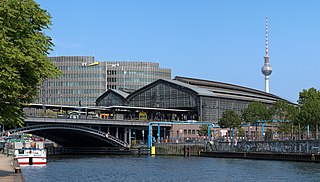
Berlin Friedrichstraße is a railway station in the German capital Berlin. It is located on the Friedrichstraße, a major north-south street in the Mitte district of Berlin, adjacent to the point where the street crosses the river Spree. Underneath the station is the U-Bahn station Friedrichstraße.

Berlin Alexanderplatz is a German railway station in the Mitte district of Berlin's city centre. It is one of the busiest transport hubs in the Berlin area. The station takes its name from its location on Alexanderplatz, near the Fernsehturm and the World Clock.

Berlin Potsdamer Platz is a railway station in Berlin. It is completely underground and situated under Potsdamer Platz in central Berlin. Regional and S-Bahn services call at the station, and it is also served by U-Bahn line U2.

Jungfernstieg is an underground railway station in the city centre of Hamburg, Germany, served by the underground railway (U-Bahn) and the suburban railway (S-Bahn). The station is one of Hamburg's busiest rapid transit hubs.
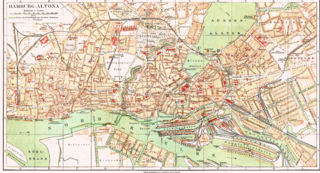
The Hamburg-Altona link line is a railway line in Hamburg, Germany. It now connects the lines from the north and west of Hamburg and Altona station with Hamburg Hauptbahnhof and the lines to the south and east. It was initially designed as a freight line only but is it now one of the busiest lines in Germany. It includes the suburban tracks of the Hamburg Stadtbahn, originally the core of the Hamburg S-Bahn.

The Berlin U-Bahn originated in 1880 with Werner Siemens' idea to build an urban railway in Berlin. During the nine years after the German Empire was founded, the city's population grew by over one-third and traffic problems increased. In 1896, Siemens & Halske began to construct the first stretch of overhead railway. On 1 April 1897, the company began construction of an electric underground railway. The Berliner Verkehrs Aktiengesellschaft (BVG) was formed in 1928, and took over further construction and operation of the network. In 1938, the company was renamed Berlin Transport Company; the original acronym, however, remained. Since 1994, the BVG has been a public company.
The tracks of the Berlin subway are lines operated in the line traffic, operating distances, which serve only internal purposes, turn-off and turning plants and plants in the operating farms.
























